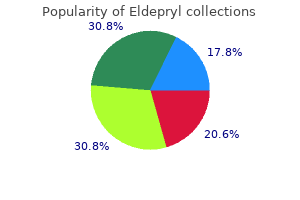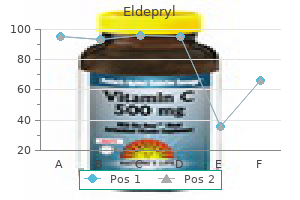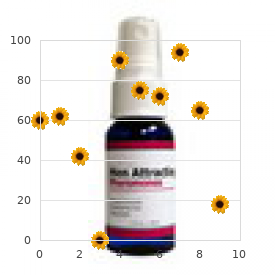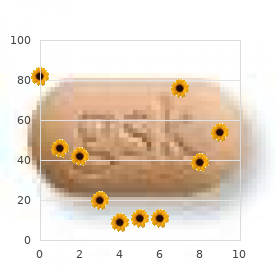

Patrizio Caturegli, M.D., M.P.H.

https://www.hopkinsmedicine.org/profiles/results/directory/profile/0009037/patrizio-caturegli
Eldepryl dosages: 5 mg
Eldepryl packs: 60 pills, 90 pills, 120 pills, 180 pills, 270 pills, 360 pills

Nevertheless, dislocation could happen during an car accident when the hip is flexed, adducted, and medially rotated, the standard position of the decrease limb when a person is driving in a automotive. A head-on collision that causes the knee to strike the dashboard might dislocate the hip when the femoral head is compelled out of the acetabulum. The joint capsule ruptures inferiorly and posteriorly, permitting the femoral head to pass 1844 by way of the tear within the capsule, and over the posterior margin of the acetabulum onto the lateral floor of the ilium, shortening and medial rotating the limb. This type of harm might 1845 lead to paralysis of the hamstrings and muscles distal to the knee supplied by the sciatic nerve. Sensory modifications may also occur within the skin over the posterolateral features of the leg and over much of the foot due to harm to sensory branches of the sciatic nerve. Anterior dislocation of the hip joint outcomes from a violent damage that forces the hip into extension, abduction, and lateral rotation. Often, the acetabular margin fractures, producing a fracture� dislocation of the hip joint. When the femoral head dislocates, it often carries the acetabular bone fragment and acetabular labrum with it. Genu Valgum and Genu Varum the femur is placed diagonally inside the thigh, whereas the tibia is nearly vertical inside the leg, creating an angle on the knee between the long axes of the bones. When normal, the angle of the femur within the thigh locations the center of the knee joint instantly inferior to the top of the femur when standing, centering the weightbearing line in the intercondylar area of the knee. A medial angulation of the leg in relation to the thigh, during which the femur is abnormally vertical and the Q-angle is small, is a deformity called genu varum (bowleg) that causes unequal weight bearing: the road of weight bearing falls medial to the center of the knee. Excess stress is placed on the medial side of the knee joint, which leads to arthrosis (destruction of knee cartilages), and the fibular collateral ligament is overstressed. A lateral angulation of the leg (large Q-angle, >17�) in relation to the thigh (exaggeration of the knee angle) is identified as genu valgum (knock-knee). Because of the exaggerated knee angle in genu valgum, the weightbearing line falls lateral to the middle of the knee. The patella, normally pulled laterally by the tendon of the vastus lateralis, is pulled even farther laterally when the leg is extended within the presence of genu valgum in order that its articulation with the femur is irregular.
Diseases

The size of the hydrocele is determined by how a lot of the processus vaginalis persists. A hydrocele of the testis is confined to the scrotum and distends the tunica vaginalis. A hydrocele of the spermatic twine is confined to the spermatic twine and distends the persistent a half of the stalk of the processus vaginalis. A congenital hydrocele of the cord and testis may communicate with the peritoneal cavity. Detection of a hydrocele requires transillumination, a process throughout which a brilliant mild is applied to the facet of the scrotal enlargement in a darkened room. The transmission of light as a red glow indicates excess serous fluid within the scrotum. Newborn male infants usually have residual peritoneal fluid of their tunica vaginalis; nonetheless, this fluid is usually absorbed in the course of the 1st 12 months of life. Certain pathological conditions, similar to injury and/or inflammation of the epididymis, may produce a hydrocele in adults. Hematocele of Testis 1038 A hematocele of the testis is a set of blood within the tunica vaginalis that results, for example, from rupture of branches of the testicular artery by trauma to the testis. Trauma might produce a scrotal and/or testicular hematoma (accumulation of blood, normally clotted, in any extravascular location). A hematocele of the testis may be related to a scrotal hematocele, resulting from effusion of blood into the scrotal tissues. Torsion of Spermatic Cord Torsion of the spermatic cord is a surgical emergency as a result of necrosis (pathologic death) of the testis could occur. The torsion (twisting) obstructs the venous drainage, with resultant edema and hemorrhage, and subsequent arterial obstruction. To prevent recurrence or prevalence on the contralateral side, which is likely, each testes are surgically fixed to the scrotal septum. Anesthetizing Scrotum Since the anterolateral surface of the scrotum is supplied by the lumbar plexus (primarily L1 fibers by way of the ilio-inguinal nerve) and the postero-inferior side is equipped by the sacral plexus (primarily S3 fibers through the pudendal nerve), a spinal anesthetic agent must be injected extra superiorly to anesthetize the anterolateral floor of the scrotum than is critical to anesthetize its posteroinferior surface.

Infarction in territories provided by the anterior choroidal, posterior cerebral and superior cerebellar arteries can be a frequent prevalence. The scientific correlates of this state are lack of consciousness, decerebrate rigidity and bilateral dilatation of the pupils with loss of mild response. The systemic blood stress turns into elevated because of elevated sympathetic tonsillar hernia (Foraminal Impaction, Cerebellar Cone) Downward displacement of the cerebellar tonsil by way of the foramen magnum happens as an early complication of 1. A massive centrally located haemorrhage is current in the midbrain as a consequence of transtentorial herniation. Caudal displacement of the diencephalon and mind stem, and central transtentorial herniation are the major contributors to the neurological dysfunction and vegetative disturbance that will result in a fatal outcome in such sufferers. Infratentorial expanding lesions Hydrocephalus, with enlargement of both lateral ventricles and the third ventricle, is the most common abnormality associated with expanding lesions within the posterior cranial fossa, whether or not they be in the fourth ventricle, inside or outdoors the cerebellum. Occasionally, the posterior inferior cerebellar arteries may be compressed, resulting in infarction within the inferior a half of one or each cerebellar hemispheres. If the posterior cranial fossa lesion has been increasing very slowly, upward herniation of the superior vermis of the cerebellum can produce appreciable distortion of the temporal lobes. This may amount to small protrusions of cortex through cranial burr holes, but when a bigger cerebral decompression has been undertaken, major portions of the cerebral hemisphere may herniate through the calvarial defects. Haemorrhagic pressure necrosis occurs increasing plenty in the posterior cranial fossa, but can also happen in association with supratentorial space-occupying lesions. The accompanying distortion of the spinomedullary junction leads to apnoea, which can occur at a stage when consciousness continues to be preserved. However, tonsillar herniation is often the last in a sequence of intracranial events, no less than certainly one of which will have already got been responsible for loss of consciousness. Most patients at this stage may even exhibit different irregular neurological indicators, such as decerebrate rigidity and impairment of brain stem reflexes. Diffuse mind swelling When intracranial stress has turn out to be elevated on account of diffuse brain swelling, the ventricles turn out to be small however 1. Note the notch, indicated by an arrow, most pronounced on the superior facet of the left cerebellar hemisphere. Continuing herniation will end in in depth ischaemic or haemorrhagic necrosis of the concerned cortex and white matter.

From a useful viewpoint, it will appear logical to discuss all three glands simultaneously in association with the anatomy of the mouth. However, from an anatomical viewpoint, significantly in dissection programs, the parotid gland is usually examined with or immediately subsequent to the dissection of the face for complete publicity of the facial nerve. Dissection of the parotid region have to be completed before dissection of the infratemporal area and muscular tissues of mastication or the carotid triangle of the neck. The submandibular gland is encountered primarily during dissection of the submandibular triangle of the neck, and the sublingual glands when dissecting the floor of the mouth. The parotid gland is enclosed within a troublesome, unyielding, fascial capsule, the parotid sheath (capsule), derived from the investing layer of deep cervical fascia. Fatty tissue between the lobes of the gland confers the flexibleness the gland should have to accommodate the movement of the mandible. The apex of the parotid gland is posterior to the angle of the mandible, and its base is said to the zygomatic arch. A transverse slice by way of the bed of the parotid gland demonstrates the connection of the gland to the surrounding constructions. The gland passes deeply between the ramus of the mandible, flanked by the muscle tissue of mastication anteriorly and the mastoid course of and sternocleidomastoid muscle posteriorly. The parotid duct turns medially on the anterior border of the masseter muscle and pierces the buccinator muscle. At the anterior border of the masseter, the duct turns medially, pierces the buccinator, and enters the oral cavity via a small orifice opposite the 2nd maxillary molar tooth. The auriculotemporal nerve and the nice auricular nerve, a department of the cervical plexus composed of fibers from C2 and C3 spinal nerves, innervates the parotid sheath. The postsynaptic parasympathetic fibers are conveyed from the ganglion to the parotid gland by the auriculotemporal nerve. Sympathetic fibers are derived from the cervical ganglia via the external carotid nerve plexus on the external carotid artery.
Jungle Weed (Opium Antidote). Eldepryl.
Source: http://www.rxlist.com/script/main/art.asp?articlekey=96501

Summary of Cranial Nerve Lesions the regional elements of the cranial nerves are described in the previous chapters, especially these for the head and neck. They are known as cranial nerves as a result of they emerge from the cranial cavity by way of foramina or fissures in the skull. Cranial nerves in relation to internal aspect of cranial base and dural formations. The tentorium cerebelli has been eliminated, and the venous sinuses have been opened on the proper side. Dura mater 2376 has been removed opening the trigeminal cave, cavernous sinus and hypophysial fossa, demonstrating contained cranial nerves, inner carotid artery, and hypophysis. On the premise of the embryologic/phylogenetic derivation of sure muscular tissues of the pinnacle and neck,1 some motor fibers conveyed by cranial nerves to striated muscle have historically been categorised as "particular visceral. The postsynaptic (postganglionic) fibers proceed to innervate easy muscles and glands. These fibers embrace visceral sensory (general visceral afferent) fibers conveying information from the carotid physique and carotid sinus. These include special sensory fibers conveying style and scent (special visceral afferent fibers) and those serving the particular senses of vision, listening to, and steadiness (special somatic afferent fibers). Summary of cranial parasympathetic ganglia and related visceral motor and sensory fiber distribution. Some cranial nerves are purely sensory, others are thought-about purely motor, and several are blended. The fibers of cranial nerves join centrally to cranial nerve nuclei- teams of neurons in which sensory or afferent fibers terminate and from which motor or efferent fibers originate. The motor nuclei are proven on the left side of the brainstem and the sensory nuclei on the proper facet. The cell our bodies of olfactory receptor neurons are positioned within the olfactory organ (the olfactory a half of the nasal mucosa or olfactory area), which is located within the roof of the nasal cavity, and alongside the nasal septum and medial wall of the superior nasal concha.
Layers of the anterolateral abdominal wall, together with the trilaminar flat muscle tissue, are shown. The anterolateral abdominal wall consists of pores and skin and subcutaneous tissue (superficial fascia) composed mainly of fat, muscle tissue and their aponeuroses and deep fascia, extraperitoneal fats, and parietal peritoneum. The pores and skin attaches loosely to the subcutaneous tissue, except at the umbilicus, the place it adheres firmly. Most of the anterolateral wall contains three musculotendinous layers; the fiber bundles of every layer run in several instructions. This three-ply construction is similar to that of the intercostal spaces within the thorax. Fascia of Anterolateral Abdominal Wall the subcutaneous tissue over most of the wall features a variable quantity of fats. Males are especially vulnerable to subcutaneous accumulation of fat in the lower anterior stomach wall. In morbid weight problems, the fats is many inches thick, often forming a number of sagging folds (L. Superior to the umbilicus, the subcutaneous tissue is according to that found in most areas. Inferior to the umbilicus, the deepest part of the subcutaneous tissue is strengthened by many elastic and collagen fibers, so it has two layers: the superficial fatty layer (Camper fascia) and the deep membranous layer (Scarpa fascia) of subcutaneous tissue. The membranous layer continues inferiorly into the perineal region as the membranous layer of subcutaneous tissue of the perineum (superficial perineal or Colles fascia), but not into the thighs. The investing fascias listed here are extremely skinny, being represented principally by the epimysium (outer fibrous connective tissue layer surrounding all 979 muscles-see Chapter 1, Overview and Basic Concepts) superficial to or between muscle tissue. The internal facet of the abdominal wall is lined with membranous and areolar sheets of various thickness constituting endoabdominal fascia.

Beginning with extended limb, retracted girdle (B); neutral position (A); flexed limb, protracted girdle (D); and, lastly, elevated limb and girdle (E). Rotation of the scapula at "scapulothoracic joint" is an integral part of abduction of the higher limb. Movements of a similar scale occur throughout elevation, melancholy, and rotation of the scapula. The articular surfaces, lined with fibrocartilage, are separated by an incomplete wedge-shaped articular disc. Although comparatively weak, the joint capsule is strengthened superiorly by fibers of the trapezius. However, the integrity of the joint is maintained by extrinsic ligaments, distant from the joint itself. The extent of the synovial membrane of the glenohumeral joint is demonstrated on this specimen during which the articular cavity has been injected with purple latex and the fibrous layer of the joint capsule has been eliminated. The coracoclavicular ligament consists of two ligaments, the conoid and trapezoid ligaments, which are often separated by a bursa related to the lateral finish of the subclavius muscle. Its extensive attachment (base of the triangle) is to the conoid tubercle on the inferior floor of the clavicle. The practically horizontal trapezoid ligament is hooked up to the superior surface of the coracoid course of and extends laterally to the trapezoid line on the inferior surface of the clavicle. Glenohumeral Joint the glenohumeral (shoulder) joint is a ball-and-socket sort of synovial joint that permits a variety of movement; nevertheless, its mobility makes the joint comparatively unstable. Dissection of the glenohumeral joint in which the joint capsule was sectioned and the joint opened from its posterior aspect as if it have been a book. The anterior, inside floor demonstrates the glenohumeral ligaments, which were incised to open the joint. The prime operate of those muscles and the musculotendinous 658 rotator cuff is to hold the comparatively large head of the humerus within the a lot smaller and shallow glenoid cavity of the scapula.

They cross through the transversus abdominis and inner indirect muscular tissues to provide the external indirect and skin of the anterolateral abdominal wall. The posterior rami pass posteriorly to supply the muscular tissues of the back and overlying 1266 pores and skin, whereas the anterior rami pass laterally and inferiorly, to provide the skin and muscle tissue of the inferiormost trunk and decrease limb. The preliminary parts of the anterior rami of the L1, L2, and occasionally L3 spinal nerves give rise to white speaking branches (L. The abdominal a part of the sympathetic trunks (lumbar sympathetic trunks), consisting of four lumbar paravertebral sympathetic ganglia and the interganglionic branches that connect them, is steady with the thoracic a half of the trunks deep to the medial arcuate ligaments of the diaphragm. The lumbar trunks descend on the anterolateral aspects of the bodies of the lumbar vertebrae in a groove shaped by the adjacent psoas major. Inferiorly, they cross the sacral promontory and continue inferiorly into the pelvis because the sacral part of the trunks. For the innervation of the stomach wall and lower limbs, synapses between the presynaptic and postsynaptic fibers happen in the sympathetic trunks. Postsynaptic sympathetic fibers journey from the lateral facet of the trunks through gray speaking branches to the anterior rami. They turn out to be the thoracoabdominal and subcostal nerves and the lumbar plexus (somatic nerves) that stimulate vasomotion, sudomotion, and pilomotion within the lowermost trunk and lower limb. Lumbar splanchnic nerves arising from the medial facet of the lumbar sympathetic trunks convey presynaptic sympathetic fibers for the innervation of pelvic viscera. The lumbar plexus of nerves is shaped anterior to the lumbar transverse processes, within the proximal attachment of the psoas major. The following nerves are branches of the lumbar plexus; the three largest are listed first: the femoral nerve (L2�L4) emerges from the lateral border of the psoas main and innervates the iliacus and passes deep to the inguinal ligament/iliopubic tract to the anterior thigh, supplying the flexors of the hip and extensors of the knee. The obturator nerve (L2�L4) emerges from the medial border of the psoas major and passes into the lesser pelvis, passing inferior to the superior pubic ramus (through the obturator foramen) to the medial thigh, supplying the adductor muscular tissues.

Note subfalcine herniation of the cingulate gyrus, which additionally reveals blurring of its cortex�white matter junction. Arrows point out one of the biopsy needle tracks, at far from the neoplasm. Although this sequence of occasions may happen with any increasing lesion inside a cerebral hemisphere, certain displacements are selectively affected by the positioning of the lesion. A lesion in the temporal lobe will produce disproportionately severe shift of the third ventricle and can displace upwards the sylvian fissure and the adjacent branches of the middle cerebral artery. As the lesion continues to increase, the next stage is the development of inside cranial hernias. The major sites of intracranial herniation are at the falx cerebri, tentorium cerebelli and foramen magnum. This could compromise circulation by way of the pericallosal arteries and result in infarction of the parietal parasagittal cortex, manifesting clinically as a weakness or sensory loss in one or both legs. A wedge of strain necrosis might happen alongside the groove where the cingulate gyrus makes contact with the falx. The width of this hernia is influenced by variations within the capability of the tentorial incisura,43 as nicely as the dimensions and placement of the mass lesion. As the parahippocampal gyrus herniates, the midbrain is narrowed in its transverse axis and the cerebral aqueduct becomes compressed. The contralateral cerebral peduncle is pushed against the opposite free tentorial edge,69 and the ipsilateral oculomotor nerve becomes compressed between the petroclinoid ligament or the free fringe of the tentorium and the posterior cerebral artery. The ensuing paralysis of oculomotor nerve produces ptosis and dilatation of the pupil ipsilateral to the lesion, with lack of the direct response to gentle shone within the affected eye and of the consensual response to mild shone in the opposite eye. Compression of the contralateral cerebral peduncle against the free fringe of the tentorium could result in infarction, with or without haemorrhage within the dorsal a part of the peduncle and adjoining tegmentum. Expansion of a supratentorial mass lesion might due to this fact be responsible for initiating tentorial herniation and establishing the beginnings of a transtentorial stress gradient. Subsequently, any course of that may usually induce a diffuse enhance in intracranial strain will improve the transtentorial strain gradient and accentuate the method of herniation; major degrees of lateral midline shift may trigger blockage of the foramen of Monro and narrowing of the cerebral aqueduct, leading to hydrocephalus. Determinants of Intracranial Pressure and Pressure/ Volume Relationships 49 Other sequelae of raised intracranial strain and tentorial herniation embrace the compression of arteries; occlusion of the anterior choroidal artery might result in infarction within the medial a half of the globus pallidus, in the inner capsule and in the optic tract.
Emet, 24 years: It may also provide a pathway for metastasis of prostatic or ovarian cancer cells to vertebral or cranial sites. The inferior floor of the shaft and the lateral surface of the medial malleolus articulate with the talus and are covered with articular cartilage.
Sanford, 58 years: Lungs: the lungs are the very important organs of respiration during which venous blood exchanges oxygen and carbon dioxide with a tidal airflow. Contrast medium was injected into the ureters from a versatile endoscope (urethroscope) within the bladder.
Rufus, 35 years: Redefining mobile phenotypy based mostly on embryonic, adult, and cancer stem cell biology. It commences at the jugular foramen in the posterior cranial fossa as the direct continuation of the sigmoid sinus (see Chapter eight, Head).
Runak, 34 years: In some cases, the mental foramina disappear, exposing the mental nerves to harm. When the root of the lung is severed and the lung is removed, the pulmonary ligament appears to hang from the basis.
Kalesch, 33 years: Both the visceral and somatic afferent fibers prolong from cell bodies within the S2�S4 spinal ganglia. Mediastinoscopy Biopsies and Mediastinal Using an endoscope (mediastinoscope), surgeons can see much of the mediastinum and conduct minor surgical procedures.
Arokkh, 22 years: A onerous blow to the humerus when the glenohumeral joint is fully abducted tilts the top of the humerus inferiorly onto the inferior weak a half of the joint capsule. The fibers of cranial nerves connect centrally to cranial nerve nuclei- groups of neurons during which sensory or afferent fibers terminate and from which motor or efferent fibers originate.
Kirk, 44 years: The time period hip pointer may also refer to avulsion of bony muscle attachments, for instance, of the sartorius or rectus femoris to the anterior superior and inferior iliac spines, respectively, of the hamstrings from the ischium. Interposed between the more rigid thorax and pelvis, this arrangement allows the abdomen to enclose and shield its contents while providing the flexibleness required by respiration, posture, and locomotion.
Lars, 61 years: Urine may cross into the loose connective tissue within the scrotum, around the penis, and, superiorly, deep to the membranous layer of subcutaneous connective tissue of the inferior anterior belly wall. The bulbs of the vestibule are paired masses of elongated erectile tissue, approximately 3 cm in length.
References
Realice búsquedas en nuestra base de datos: